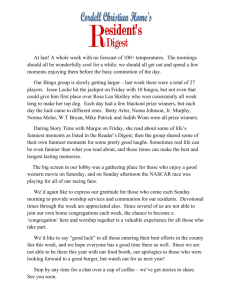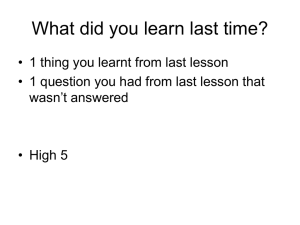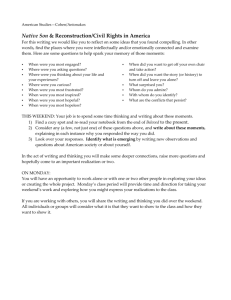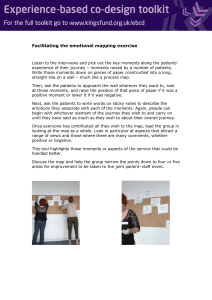TC_Writing_Guide_for_Parents
advertisement
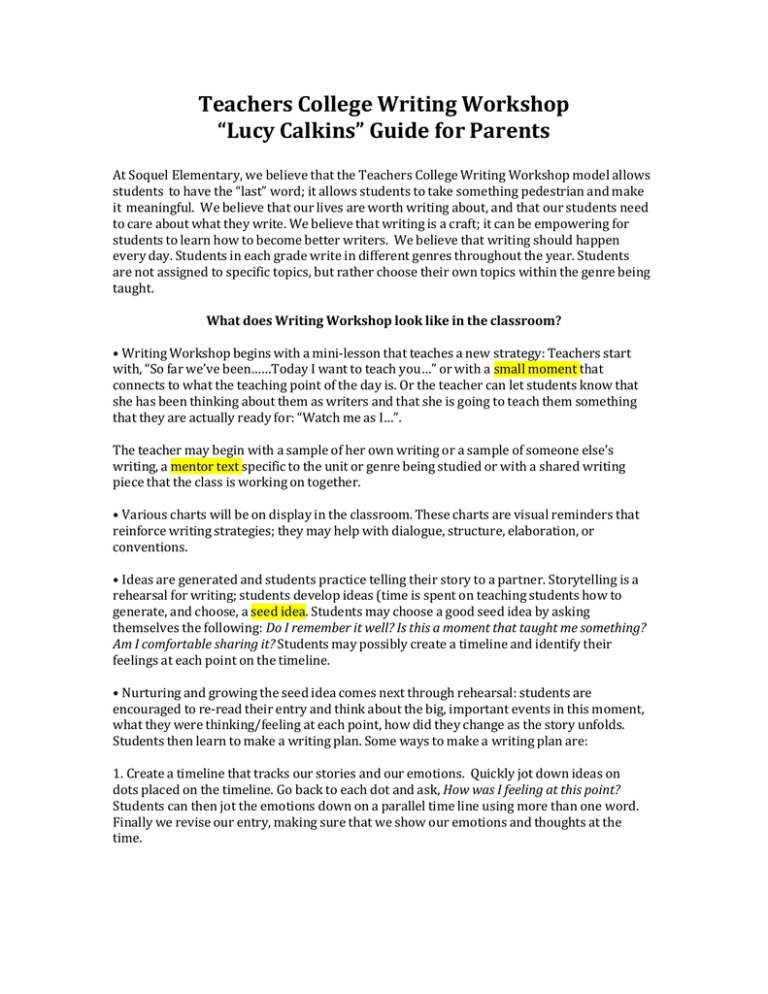
Teachers College Writing Workshop “Lucy Calkins” Guide for Parents At Soquel Elementary, we believe that the Teachers College Writing Workshop model allows students to have the “last” word; it allows students to take something pedestrian and make it meaningful. We believe that our lives are worth writing about, and that our students need to care about what they write. We believe that writing is a craft; it can be empowering for students to learn how to become better writers. We believe that writing should happen every day. Students in each grade write in different genres throughout the year. Students are not assigned to specific topics, but rather choose their own topics within the genre being taught. What does Writing Workshop look like in the classroom? • Writing Workshop begins with a mini‐lesson that teaches a new strategy: Teachers start with, “So far we’ve been……Today I want to teach you…” or with a small moment that connects to what the teaching point of the day is. Or the teacher can let students know that she has been thinking about them as writers and that she is going to teach them something that they are actually ready for: “Watch me as I…”. The teacher may begin with a sample of her own writing or a sample of someone else’s writing, a mentor text specific to the unit or genre being studied or with a shared writing piece that the class is working on together. • Various charts will be on display in the classroom. These charts are visual reminders that reinforce writing strategies; they may help with dialogue, structure, elaboration, or conventions. • Ideas are generated and students practice telling their story to a partner. Storytelling is a rehearsal for writing; students develop ideas (time is spent on teaching students how to generate, and choose, a seed idea. Students may choose a good seed idea by asking themselves the following: Do I remember it well? Is this a moment that taught me something? Am I comfortable sharing it? Students may possibly create a timeline and identify their feelings at each point on the timeline. • Nurturing and growing the seed idea comes next through rehearsal: students are encouraged to re‐read their entry and think about the big, important events in this moment, what they were thinking/feeling at each point, how did they change as the story unfolds. Students then learn to make a writing plan. Some ways to make a writing plan are: 1. Create a timeline that tracks our stories and our emotions. Quickly jot down ideas on dots placed on the timeline. Go back to each dot and ask, How was I feeling at this point? Students can then jot the emotions down on a parallel time line using more than one word. Finally we revise our entry, making sure that we show our emotions and thoughts at the time. 2. Take small moments and break them into beginning, middle and end. Develop the tension and the problem. The problem is not the event. Use box pictures. Tell the story using the boxes. Draw pictures and label them with words. Adding words helps formulate the story. 3. Make a story booklet with illustrations of four major events – this forces students to remember and start thinking about major themes. • Students then tell their story to their writing partner. They show each other their sketches., and they may be prompted to add more pictures and words. Partners ask questions like, What would they be saying? What would they be thinking? Students can draw dialogue boxes to reflect inner thinking.; it is often easier to hear voice before writing – the teacher may say, “How can you bring that feeling out with your words?” • Drafting is the next step in the process. Writers get ready to draft by thinking about meaning…they are taught to ask themselves, What am I trying to say? What is my story really about? Paper choices vary according to grade level, and there is paper choice within each grade level. Students may draft with just picture boxes, or older students may draft on “black dot” paper with lines skipped so that there is room to go back and add new ideas and revisions. Students in upper grades are encouraged to write “long and strong,” or “fast and furious” using thought prompts to push our thinking (all in all, what I mean is, this is important because…) They consider how to begin…with dialogue, setting, action, or inner thought. They usually spend a day writing out the entire story. Teachers are modeling throughout this process: For example, a teacher may share, “My story is really about how when you’re a teenager, your parents become embarrassing. For example…” • A few days of revision then occur. Teachers do not mark up students’ papers with edits, but rather facilitate a process where the students themselves are thinking about what to revise. The teacher may encourage the use of prompts to push our thinking include: for example, another example, in addition, in other words, on the other hand, this is important because, all in all, what I’m saying is….The goal is to stretch out the heart of the story, or what the writer believes the story is really about. The editing process also includes a focus on grammar, punctuation, and mechanics. Students may use an editor’s checklist. Students learn that good stories have dialogue, detail, inner thinking and setting. This is what we are looking for when we revise. The teacher may demonstrate, and then have the students try it: “Watch me, now you try it right now in your piece.” The teacher may also demonstrate by having students look at a generic text; students all work at once on adding dialogue, for example. The teacher may demonstrate by showing the students a mentor text of a great writer. The teacher encourages students to try a similar style in their own writing. • The publishing process (writing celebration) can take place in many different ways: a museum walk where students walk around and read others’ writing posted all over the wall, student read‐alouds in front of the class, a publishing party with parents, leaving writing out on students’ desks and having others walk around the room, read the stories silently, and leave a comment. The students are taught that their writing is not solely for the teacher anymore; it is to be celebrated by al WRITING STRATEGIES TO USE AT HOME WITH YOUR CHILD Encourage your child to carry their writer’s notebook with them, paying attention to details and thinking, “I could write a true story about this.” Think of a strong feeling, and then list “small moment” stories pertaining to that feeling. Choose one to write about. Think of the stories that your family tells and retells. Write about one of those. Keep an ongoing list of story ideas in your writer’s notebook. Think of a subject, or a person, place, or thing that matters to you, then list small moments you remember. Choose one to sketch and then write the accompanying story. You can make a T chart of small moments. Think about people in our lives that are important to us. Think of a specific person and memories; make a list and generate ideas. Then talk to someone at home about it. Think of first times, last times, or important times in your life. Write about one of those moments. You can make an Issues/People/Moments chart: focus on the ordinary, everyday tension filled moments; or think of a person who matters to you, then think of small moments spent with that person. From these moments, choose one to write about. Or think of an issue (i.e. peer pressure, parents embarrassing you) and do the same thing. Diagram places of memory and label the pictures with individual words Use a book and look at the moments and relationships and see what you connect to and may want to examine in your own life. Take small moments and break them into beginning, middle and end. Develop the tension and the problem. Tell the story using the boxes. Draw pictures and label them with words. Adding words helps form a foundation for formulating the story. Encourage your child to “show, don’t tell.” How to begin? Begin with a strong lead: ‐setting: “One warm September day…” or • setting: “Cobwebs filled the air.” The setting should reflect what the environment/place looks like and feels like. Students are encouraged to start with the five senses, and add details on from there. ‐action: “The kitten scratched at the door…” or “I ran across the stage….” ‐dialogue: “‘Shhh,’ called his mother.” Dialogue should reflect the kind of person the character is, including his/her tone of voice and characteristic speech. Students have learned how to respond to a teacher modeling writing cues; for example, if a student writes, “She said she was mad,” the teacher may encourage the student to a) attach a tone to that statement, such as “she whispered,” or “she yelled” and b) add an action “she said as she was brushing her hair.” ‐question: “Have you ever?...” ‐exclamation: “Wow!” Inner Thinking is a way of showing a character’s emotions; you can work on this with your child by helping them summarize their emotion, such as “I was afraid” and showing “My heart races. Sweat dripped down…” How to end? Stay close to what s most important at the end. Encourage your child to “show, don’t tell;” i.e. “He jumped up and down. He shouted “Hooray!” as opposed to “He was happy.” Teachers College Writing Workshop Vocabulary (or Frequently Used Terms) Small Moment: Students learn to take the everyday events of their lives and stretch them into focused, well‐structured stories. Seed Idea: To create to a really good story, it helps to think of a smaller subject, or seed, within the big watermelon topic. Long and Strong: Developing stamina increases student output on tests. There have been reports that high SAT scores are directly related to the length of the piece. Writing gibberish isn’t going to make a good piece, but learning how to write long AND strong is important for kids to know how to do. Heart of the Story: Students are taught to find the "heart of the story" and stretch it out to an event‐by‐event sequence. Play a Movie in your Mind: Students can make a movie in their mind to support what is happening in the story they are reading or writing. This helps students visualize the events in the story, enhances comprehension while reading and allows a writer to add greater detail to their piece. Show Don’t Tell: Imagery is language that paints a vivid picture in the mind of the reader. Storytelling: Writing in the air; it is important to teach the difference between storytelling and reporting. Fancy it up: Adding details and elaborating.

